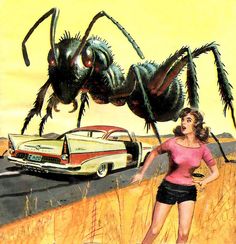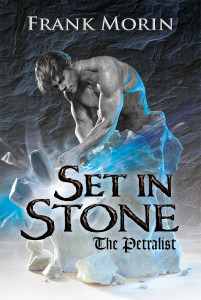It seems that anyone who wants to write in the action, adventure, or thriller genres has to have a bazillion air miles on their cards in order to fly out to all of those exotic locations, write that section of the story, and then jet off to the next locale. What if you want to write about those places but don’t have the means?
There’s a couple of things you can do.
Wing It and Make It All Up
 Yes, this is an option. You can set your mutant giant ant story in Nevada, and they all die because they’re allergic to saguaro cactus. The problem with this is saguaros live in the Sonora Desert in Arizona.
Yes, this is an option. You can set your mutant giant ant story in Nevada, and they all die because they’re allergic to saguaro cactus. The problem with this is saguaros live in the Sonora Desert in Arizona.
Winging it will require a lot of research for almost everything you want to do in your designated setting — if it exists in real life. Should you set your tale in a world made of cheeses and populated by naked mole rats, you’re free to make up everything to your heart’s content. The one thing you will need to do is make sure that once you set a rule you follow it, just like the laws of physics on Earth. If your characters have to keep one foot on the ground else they float off towards the ever-present giant hungry mouth floating in the sky, they can’t ever jump for joy or fall off of a building.
Whatever rules you develop, you’re stuck with them. If you change things mid-story, your readers will be irate.
Limit Your Story to Somewhere You’ve Lived
If you happen to be a former military member (thank you for your service), the spouse of one (also thank you for your service), or even a military brat that visited and/or lived in different countries, congratulations. You should have enough background to write a story with the general look and feel of that locale.
There are a few caveats, though. You’re familiar with that area for a specific time period. If I wanted to write a story about Brooklyn from my time living there, it would be from the late nineteen-sixties or -seventies. That’s the ballpark swath of time my memories are based on. If I wanted to have two characters meet at Elaine’s Avenue M Deli, that wouldn’t work for a 1970-era tale. Elaine’s started their business in 2001. People who are familiar with that area will know this and it will knock them out of the book.
 You could always make up an establishment, but make sure you’re vague enough that people can’t say, “Oh, that’s where DiFara’s Pizza is. He’s been there since 1965. Also known as one of the very best places to get a pizza in the galaxy.”
You could always make up an establishment, but make sure you’re vague enough that people can’t say, “Oh, that’s where DiFara’s Pizza is. He’s been there since 1965. Also known as one of the very best places to get a pizza in the galaxy.”
Beyond the businesses and buildings, the overall look and feel of places change over time. What you remember as a gritty blue-collar area might have been gentrified, slowly filling up with hipsters and people with sculpted beards drinking Starbucks through a straw. If you still know people from the old neighborhood, get them on the phone or drop an email asking them to tell you how things are these days. It gives you a good excuse to call your old Uncle Johnny and Aunt Grace and chat for an hour, assuming they’re not late for a Groupon appointment offering buy one, get one free skydiving lessons.
Oh, and for folks who don’t think Brooklyn isn’t an exotic location, try visiting it. Besides, it’s the capital of the known universe and the place to go when one wants the best pizza.
Google Street View
This is one of the best things to help authors since instant coffee. While it doesn’t cover the entire globe, it will certainly do a decent job of letting you know what most places look like within the last couple of years.
If you want to virtually be in an Eagle’s song, you can go stand on a corner in Winslow, Arizona. In fact, there is a park dedicated to that very activity, including a statue. In some shots, you may even find a flatbed Ford.
Now it is possible to walk (or drag your cursor) through places like Prague or Berlin. If you want to describe your spy running through the Palazzo Poggi Museum at the University of Bologna, Italy, you can describe dashing through the doorway between the sculpture of a nude woman and a human skeleton.
Travel Books
While geared more towards tourists, picking up a Lonely Planet or Fodor’s travel guide can help you to bring some realism to your exotic settings. If your budget is limited, you can always visit your local library for the latest copy or pick up one from a year or two prior from used bookstores or a library sale.
These guides give you a good flavor of each area, discuss some of the unique qualities and places hidden within each locale, and sometimes include iconic things to do and see. People who live there or have visited will certainly remember Damnoen Saduak Floating Market or the giant maze that makes up the Chatuchak Weekend Market just off of Phahonyothin Road. It’s easy to get lost in there, and an excellent spot for your spy to ditch the folks following her. The extensive descriptions will help you to get the feel of the place and fire up descriptions of all senses.
Just Google It
In the end, you can just give Google Search a shot. This is probably the most used method authors use, so you may end up missing out on the spots that are off of the beaten path. Try to dig into reviews of places to get visitors opinions. Maybe the museum is nice but it smells like fish because of the cannery next door. Those little details will help to solidify the setting with your readers, especially folks with the travel experience.
After all, it may help you to properly plan the extermination of that giant radioactive ant problem your characters have if you shift them so they’re standing on a corner in Winslow, Arizona.







